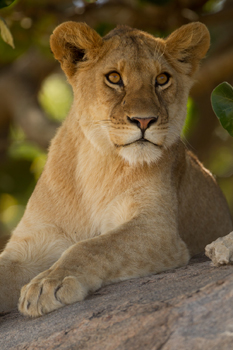

Tanzania
the Northern Serengeti
Ngorongoro Crater
Tarangire
October 4-16, 2014
Price: $10250
Optional:
Tanzania Bat Shoot Extention
Oct 16-18, 2014
Add: $2595


Tanzania
the Northern Serengeti
Ngorongoro Crater
Tarangire
October 4-16, 2014
Price: $10250
Optional:
Tanzania Bat Shoot Extention
Oct 16-18, 2014
Add: $2595
Tanzania
the Northern Serengeti
Ngorongoro Crater
Tarangire
the Northern Serengeti
Ngorongoro Crater
Tarangire
October 4-16, 2014
Price: $10250
Optional:
Tanzania Bat Shoot Extention
Oct 16-18, 2014
Add: $2595
Limited to 13 people
Check out our
trip reports for more information, too!
An Exclusive Shoot Limited to Thirteen Photographers
Only three photographers per vehicle
The Northern Serengeti
The Serengeti as a wilderness location is truly one of the greatest natural wonders in the world.
Some History
For years Mary and I have filmed the gnu migration in Kenya, which is climaxed, when we're lucky, by gnus crossing the Mara River. In 2011 we scouted out the Serengeti for doing possible trips to Tanzania at a future date, as we feared that Kenya's political and ecological stability might change at some future time. While we still consider Kenya's Masai Mara to be one of the premiere shooting locations worldwide, the fact is, the Mara is changing, and not for the better. We've seen huge changes over the last several years, mainly due to the increasing encroachment of the Maasai into both park boundary areas and within the park itself. Overgrazing has denuded peripheral areas that were once great game viewing spots, and with more cattle and goats, there's the likelihood that some leopards, hyenas, and lions will kill stock and be killed in retaliation. This has happened, with lions and leopards we 'knew' and had filmed.
In all honesty, we looked to Tanzania as an alternative to Kenya if, or when, that country no longer afforded quality, or safe, photographic safaris. We were hoping that Tanzania would be an adequate substitute, nothing more. In fact we had deluded ourselves for years thinking that the southern Masai Mara, where we spend time on all of our Kenya trips, was quite similar to the Serengeti, so, who needed Tanzania?
We were so wrong on so many counts. The Serengeti proved to be far more than a substitute for the Mara, and the experience, the landscapes, and the wildlife was quite different, and extremely rewarding. Here's the details to our visit to several unique locations:
The Northern Serengeti
As you may know, the Serengeti is a derivative of a Maasai word for endless plains or endless grasses, and much of the Serengeti is indeed a huge and seemingly limitless vast grassland. One advantage the Northern Serengeti has over neighboring Kenya's southern edge of the Masai Mara is that this area is just one small section of a protected region that extends for scores of miles in either direction. In the Mara, as I pointed out above, there is only a thirty mile width before you are out of the park, and into the increasingly developed countryside. In the Northern Serengeti, you'll drive for nearly an entire day in either direction before reaching that the edges of the park. Consequently, there is a lot of game!

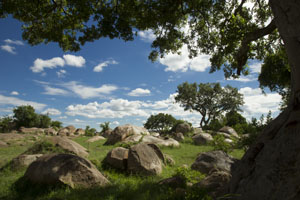
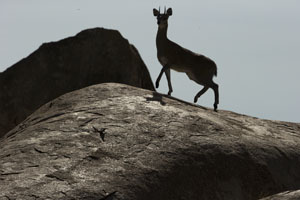
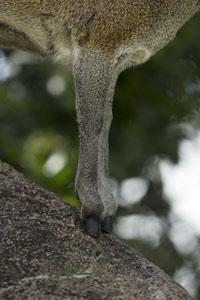 Although much of our game driving, and the location of our luxury mobile camp, is just miles from the border, and we can actually see the antenna of the Mara Serena Lodge at times, the habitat is shockingly different. We were amazed, for here in the northern Serengeti we found some of the most beautiful kopjes we've seen anywhere in the Serengeti. In contrast, there are no true kopjes in the Mara, just miles away! In these photogenic rock formations we might find Leopard, Lion, and almost certainly the interesting and delicate antelope, the Klipspringer, which walks along rocks and cliffs, balanced on the tips of its hooves. Black Rhinos are here, although probably still as threatened by poaching as they are anywhere else. On average, in 2012-13, more than one Black Rhino was killed per day in Africa by poachers! Rhinos give birth to just one baby, after a gestation of 15 or 16 months. Most of this poaching occurs in southern Africa, but no where are these animals safe, and if the trend continues rhinos will soon be extinct in the wild. We have a good chance of seeing and photographing Black Rhinos, either here in the Northern Serengeti or in the Ngorongoro Crater.
Although much of our game driving, and the location of our luxury mobile camp, is just miles from the border, and we can actually see the antenna of the Mara Serena Lodge at times, the habitat is shockingly different. We were amazed, for here in the northern Serengeti we found some of the most beautiful kopjes we've seen anywhere in the Serengeti. In contrast, there are no true kopjes in the Mara, just miles away! In these photogenic rock formations we might find Leopard, Lion, and almost certainly the interesting and delicate antelope, the Klipspringer, which walks along rocks and cliffs, balanced on the tips of its hooves. Black Rhinos are here, although probably still as threatened by poaching as they are anywhere else. On average, in 2012-13, more than one Black Rhino was killed per day in Africa by poachers! Rhinos give birth to just one baby, after a gestation of 15 or 16 months. Most of this poaching occurs in southern Africa, but no where are these animals safe, and if the trend continues rhinos will soon be extinct in the wild. We have a good chance of seeing and photographing Black Rhinos, either here in the Northern Serengeti or in the Ngorongoro Crater.
The Wildebeest or Gnu migration should be in the area, perhaps traveling north to cross the Mara River or doing just the opposite, and moving south. It is impossible to say, although 'normally,' historically, the Gnus moved north into the Masai Mara in late June or July, and started heading south out of the area in September or October. Over the years, however, we've seen the plains of the Mara empty in October and crowded with Gnus a month later. Gnus follow the rains, at least to an extent, but eventually most move south to be at their birthing grounds in the southern Serengeti by February. If the Gnus are here, we'll have a great chance at photographing them at several different crossing points.

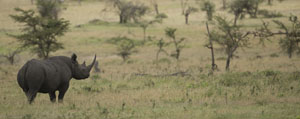
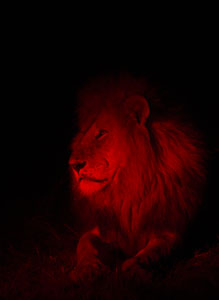
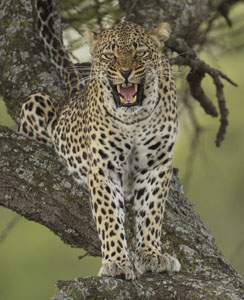
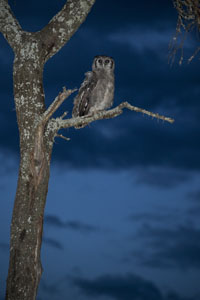
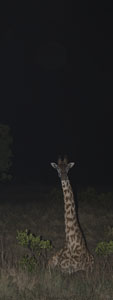
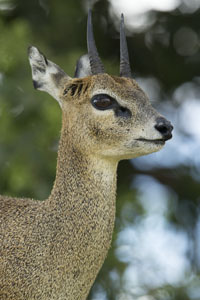
Mara River, from the Tanzania side; endangered Black Rhino; male Lion by spotlight;
an angry Leopard; Verreaux's Eagle Owl and Giraffe on the night game drive;
Klipspringer.
From our first camp we'll drive east to the border of the Serengeti where we'll stay at our lodge, the Buffalo Luxury Camp, located outside the park boundaries. From our base here we'll drive into the park for photography, where, on our scouting trip, we had excellent luck with Leopards. Since we're outside the park we will be able to do NIGHT GAME DRIVES, an activity I've highlighted because this is the only location where this will be possible and we had so much fun when we did this on our scouting trip. Photography can be difficult, but we did manage to take some very interesting images just using the vehicle's spotlight. I can tell you, it is quite exciting to be sitting in total darkness in an open vehicle next to a roaring male lion. Read more on this on the scouting report posting.
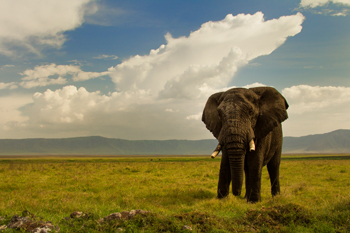
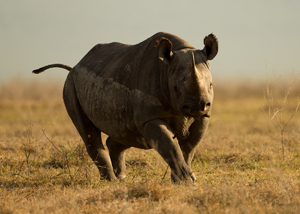
The Ngorongoro Crater
From the Serengeti we'll drive to the world famous Ngorongoro Crater, one of the wonders of the world, which never fails to amaze. Wildlife here is among the most habituated and accessible in all of East Africa, with some of the largest tusker bull elephants, a healthy black rhino population, and a variety of birds and mammals. We'll spend a full day in the Crater, where we should have luck with these great Elephants, as well as the variety of plains game and birds. Spotted Hyenas, Lions, Servals, Hippos, various birds of prey, and more, the Crater offers plenty of subjects.


We'll be spending one full day in the Ngorongoro Crater, camping near the crater rim at our outfitter's new luxury camp, Lion's Paw. We're very excited about this, and getting away from the overwhelming and often unpleasant tourist experience that staying at one of the rim's lodges presents. Mary and I camped there 15 years ago, and it was wonderful. Today, you cannot camp in the crater, and the number of lodges along the crater's rim has probably tripled. There is NO off-road driving in the crater (regardless of vague claims to the contrary), and there is a fair amount of traffic. The Crater is great for bull elephants - some of the largest bulls we've seen, and you can get close. It has a fairly good concentration of black rhinos, which may, or may not, be close to the road. Lions, hyenas, and game animals are usually pretty good shooting in the Crater, and the bird shooting was great.

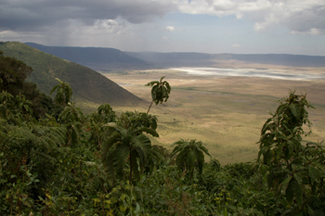

Views from the Crater Rim and inside the Crater, with a Black Rhino.
Tarangire
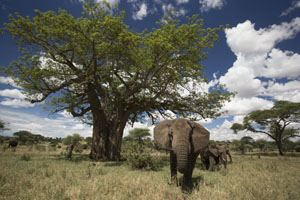 Our last stop is a half day's drive to Tarangire National Park, which will offer completely different and unique scenery of massive and primitive baobob trees, great elephant herds, and much more. Tarangire is a dry habitat, quite unlike the lush grasslands of the other two locations, and with it the park offers an entirely new set of photographic opportunities. Elephants are common, and with the Baobob trees there are wonderful shooting opportunities.
Our last stop is a half day's drive to Tarangire National Park, which will offer completely different and unique scenery of massive and primitive baobob trees, great elephant herds, and much more. Tarangire is a dry habitat, quite unlike the lush grasslands of the other two locations, and with it the park offers an entirely new set of photographic opportunities. Elephants are common, and with the Baobob trees there are wonderful shooting opportunities.
As I write this, Tarangire has a very large pack of African Wild Dogs in the area. The Wild Dog is one of the most endangered African predator but this wonderful predator is found in several locations in Tanzania. Dogs are wide ranging, however, and although they often hunt at dawn and dusk they can be anywhere. In a normal year, dogs would be finished up their annual denning at this time, and could be more easily located. But there are no guarantees with dogs, and we may see them in the most unexpected of places, or not at all. Further, at the end of the safari participants will have the option of extending their stay at this park for more shooting, including our absolutely unique bat photography session on two evenings.
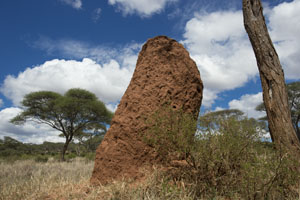

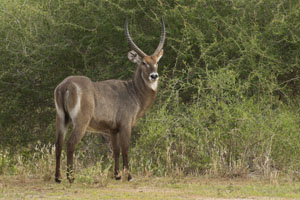
The Bat Shoot
One of my objectives for our scouting trip in 2012 was to check out a report for great bat photography at a location in Tarangire. We visited the location and found it perfect for shooting, and we felt that it would make a wonderful addition to our traditional offerings. I'll be setting up a Range IR to trip our flashes as scores or hundreds of bats fly out of the Baobob tree where they roost during the day. You, the participant, will have your camera and lens on a tripod, aimed and focused at the target point, and fire away, remotely, perhaps while you are having diner! During the two days of this extension we'll be in the field in Tarangire, photographing the wildlife and birds, and hopefully tracking down the Wild Dogs, and in the evening, for an hour or two, you'll be shooting bats. With two days of shooting you'll have a chance to refine compositions or camera placement, giving you some extraordinary images to complete your Tanzania portfolio.
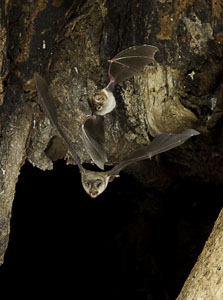
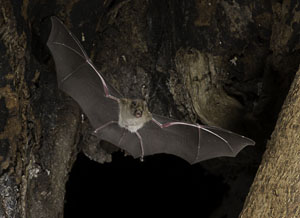

To get the most out of your safari and for all of your future photography, we'd recommend taking our
Digital Complete Nature Photo Course next summer.
Our Lodging and Our Vehicles: This is a luxury trip, not because we're spoiling ourselves or you, but because it truly is the only way to go and to be comfortable.
The luxury camps are fantastic. That statement is really an understatement, as the camp staff is simply wonderful, the food exquisite, and the accommodations great. People simply hate leaving the camp, and feel that that experience was truly as close to experiencing the sense of 'an African safari' as one could possibly have. Camping involves chemical toilets, but they function just like a flush toilet or a boat's toilet, and there is a real luxury in not having to leave your tent to hit the head in the middle of the night! In addition to its own toilet tent each two-person tent has its own shower tent. Both smaller tents are connected to the main tent and are accessed by exiting through the back flap. The tents have real beds, not cots, and all the amenities are there - it is comfortable and pleasant, and a real reward at the end of the day. You'll love them!
On the road, our vehicles have coolers with BOTTLED WATER, as well as soft drinks, and our field meals were great. Our camp dinners, at night, were superb, especially when you consider the cooking conditions.
What is included:
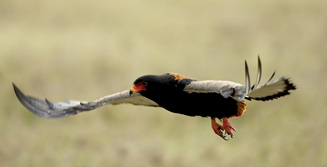
The price of the trip is based upon double occupancy, from Arusha and includes: all accommodations, including the three fabulous luxury tented camps; all park and camping fees; all special permit fees; Flying Doctors membership; internal Air Flights (to our first camp in the Northern Serengeti); all meals; bottled water and soft drinks while on game drives; unlimited water, soft drinks and laundry in the luxury mobile camp. What's not included: items of a personal nature; drinks, alcoholic beverages and laundry at the camps or lodges; alcoholic beverages; international airfare to and from Arusha; and any single supplement.
About Your Leaders
My wife Mary Ann and I strive to provide the most comfortable and thorough safari you will experience. Both Mary and I are professional photographers, and I'd hope you've seen our credits. These included National Geographic, National Wildlife, Ranger Rick, Natural History, Living Bird, Birder's World, and most nature/wildlife calendars.
In 1994 Mary Ann won two first place awards in the prestigious BBC Wildlife Photographer of the Year competition, in Endangered Species and in Bird Behavior. In 1998 she had three highly commended images published in the BBC competition, ALL THREE from Kenya! She won first place in the Cemex/Nature's Best photo contest in the Humor Division for Professional Photographers. In 2003 she won first place in Mammal Behavior in the Agfa all Africa photo competition with a dust bathing bull elephant from Samburu. Mary has written a number of children's books, including Leopards, Grizzly Bears, Woodpeckers, Flying Squirrels, Sunflowers, Cobras, Jupiter, Boas, Garter Snakes, Pythons, Rattlesnakes, Ducks, Chickens, Horses, and Cows, and a coffee table book, Out of the Past, Amish Tradition and Faith.
I've written several how-to wildlife photography books -- A Practical Guide to Photographing American Wildlife, The Wildlife Photographer's Field Manual, The Complete Guide to Wildlife Photography, Designing Wildlife Photographs, Photographing on Safari, A Field Guide to Photographing in East Africa, and the New Complete Guide to Wildlife Photography. In 1999 Todtri published my latest, African Wildlife, and in 1999 we produced our first instructional video, A Video Guide to Photographing on Safari with Joe and Mary Ann McDonald. The video has received rave reviews, and it is the definitive guide for preparing yourself for a safari. I've won several times for highly commended images in both the Cemex/Nature's Best and the Agfa all Africa photo competitions. In 2003 I won 2nd place in the World in Our Hands category in the BBC competition with an image from the Ndutu area of the Serengeti.
Email:info@hoothollow.com
Phone: 717-543-6423
Or FAX us at: (717) 543-5342
Return to Home Page
The Northern Serengeti
The Serengeti as a wilderness location is truly one of the greatest natural wonders in the world.
Some History
For years Mary and I have filmed the gnu migration in Kenya, which is climaxed, when we're lucky, by gnus crossing the Mara River. In 2011 we scouted out the Serengeti for doing possible trips to Tanzania at a future date, as we feared that Kenya's political and ecological stability might change at some future time. While we still consider Kenya's Masai Mara to be one of the premiere shooting locations worldwide, the fact is, the Mara is changing, and not for the better. We've seen huge changes over the last several years, mainly due to the increasing encroachment of the Maasai into both park boundary areas and within the park itself. Overgrazing has denuded peripheral areas that were once great game viewing spots, and with more cattle and goats, there's the likelihood that some leopards, hyenas, and lions will kill stock and be killed in retaliation. This has happened, with lions and leopards we 'knew' and had filmed.
In all honesty, we looked to Tanzania as an alternative to Kenya if, or when, that country no longer afforded quality, or safe, photographic safaris. We were hoping that Tanzania would be an adequate substitute, nothing more. In fact we had deluded ourselves for years thinking that the southern Masai Mara, where we spend time on all of our Kenya trips, was quite similar to the Serengeti, so, who needed Tanzania?
We were so wrong on so many counts. The Serengeti proved to be far more than a substitute for the Mara, and the experience, the landscapes, and the wildlife was quite different, and extremely rewarding. Here's the details to our visit to several unique locations:
The Northern Serengeti
As you may know, the Serengeti is a derivative of a Maasai word for endless plains or endless grasses, and much of the Serengeti is indeed a huge and seemingly limitless vast grassland. One advantage the Northern Serengeti has over neighboring Kenya's southern edge of the Masai Mara is that this area is just one small section of a protected region that extends for scores of miles in either direction. In the Mara, as I pointed out above, there is only a thirty mile width before you are out of the park, and into the increasingly developed countryside. In the Northern Serengeti, you'll drive for nearly an entire day in either direction before reaching that the edges of the park. Consequently, there is a lot of game!



 Although much of our game driving, and the location of our luxury mobile camp, is just miles from the border, and we can actually see the antenna of the Mara Serena Lodge at times, the habitat is shockingly different. We were amazed, for here in the northern Serengeti we found some of the most beautiful kopjes we've seen anywhere in the Serengeti. In contrast, there are no true kopjes in the Mara, just miles away! In these photogenic rock formations we might find Leopard, Lion, and almost certainly the interesting and delicate antelope, the Klipspringer, which walks along rocks and cliffs, balanced on the tips of its hooves. Black Rhinos are here, although probably still as threatened by poaching as they are anywhere else. On average, in 2012-13, more than one Black Rhino was killed per day in Africa by poachers! Rhinos give birth to just one baby, after a gestation of 15 or 16 months. Most of this poaching occurs in southern Africa, but no where are these animals safe, and if the trend continues rhinos will soon be extinct in the wild. We have a good chance of seeing and photographing Black Rhinos, either here in the Northern Serengeti or in the Ngorongoro Crater.
Although much of our game driving, and the location of our luxury mobile camp, is just miles from the border, and we can actually see the antenna of the Mara Serena Lodge at times, the habitat is shockingly different. We were amazed, for here in the northern Serengeti we found some of the most beautiful kopjes we've seen anywhere in the Serengeti. In contrast, there are no true kopjes in the Mara, just miles away! In these photogenic rock formations we might find Leopard, Lion, and almost certainly the interesting and delicate antelope, the Klipspringer, which walks along rocks and cliffs, balanced on the tips of its hooves. Black Rhinos are here, although probably still as threatened by poaching as they are anywhere else. On average, in 2012-13, more than one Black Rhino was killed per day in Africa by poachers! Rhinos give birth to just one baby, after a gestation of 15 or 16 months. Most of this poaching occurs in southern Africa, but no where are these animals safe, and if the trend continues rhinos will soon be extinct in the wild. We have a good chance of seeing and photographing Black Rhinos, either here in the Northern Serengeti or in the Ngorongoro Crater.
The Wildebeest or Gnu migration should be in the area, perhaps traveling north to cross the Mara River or doing just the opposite, and moving south. It is impossible to say, although 'normally,' historically, the Gnus moved north into the Masai Mara in late June or July, and started heading south out of the area in September or October. Over the years, however, we've seen the plains of the Mara empty in October and crowded with Gnus a month later. Gnus follow the rains, at least to an extent, but eventually most move south to be at their birthing grounds in the southern Serengeti by February. If the Gnus are here, we'll have a great chance at photographing them at several different crossing points.







Mara River, from the Tanzania side; endangered Black Rhino; male Lion by spotlight;
an angry Leopard; Verreaux's Eagle Owl and Giraffe on the night game drive;
Klipspringer.
From our first camp we'll drive east to the border of the Serengeti where we'll stay at our lodge, the Buffalo Luxury Camp, located outside the park boundaries. From our base here we'll drive into the park for photography, where, on our scouting trip, we had excellent luck with Leopards. Since we're outside the park we will be able to do NIGHT GAME DRIVES, an activity I've highlighted because this is the only location where this will be possible and we had so much fun when we did this on our scouting trip. Photography can be difficult, but we did manage to take some very interesting images just using the vehicle's spotlight. I can tell you, it is quite exciting to be sitting in total darkness in an open vehicle next to a roaring male lion. Read more on this on the scouting report posting.


The Ngorongoro Crater
From the Serengeti we'll drive to the world famous Ngorongoro Crater, one of the wonders of the world, which never fails to amaze. Wildlife here is among the most habituated and accessible in all of East Africa, with some of the largest tusker bull elephants, a healthy black rhino population, and a variety of birds and mammals. We'll spend a full day in the Crater, where we should have luck with these great Elephants, as well as the variety of plains game and birds. Spotted Hyenas, Lions, Servals, Hippos, various birds of prey, and more, the Crater offers plenty of subjects.


We'll be spending one full day in the Ngorongoro Crater, camping near the crater rim at our outfitter's new luxury camp, Lion's Paw. We're very excited about this, and getting away from the overwhelming and often unpleasant tourist experience that staying at one of the rim's lodges presents. Mary and I camped there 15 years ago, and it was wonderful. Today, you cannot camp in the crater, and the number of lodges along the crater's rim has probably tripled. There is NO off-road driving in the crater (regardless of vague claims to the contrary), and there is a fair amount of traffic. The Crater is great for bull elephants - some of the largest bulls we've seen, and you can get close. It has a fairly good concentration of black rhinos, which may, or may not, be close to the road. Lions, hyenas, and game animals are usually pretty good shooting in the Crater, and the bird shooting was great.



Views from the Crater Rim and inside the Crater, with a Black Rhino.
Tarangire
 Our last stop is a half day's drive to Tarangire National Park, which will offer completely different and unique scenery of massive and primitive baobob trees, great elephant herds, and much more. Tarangire is a dry habitat, quite unlike the lush grasslands of the other two locations, and with it the park offers an entirely new set of photographic opportunities. Elephants are common, and with the Baobob trees there are wonderful shooting opportunities.
Our last stop is a half day's drive to Tarangire National Park, which will offer completely different and unique scenery of massive and primitive baobob trees, great elephant herds, and much more. Tarangire is a dry habitat, quite unlike the lush grasslands of the other two locations, and with it the park offers an entirely new set of photographic opportunities. Elephants are common, and with the Baobob trees there are wonderful shooting opportunities.
As I write this, Tarangire has a very large pack of African Wild Dogs in the area. The Wild Dog is one of the most endangered African predator but this wonderful predator is found in several locations in Tanzania. Dogs are wide ranging, however, and although they often hunt at dawn and dusk they can be anywhere. In a normal year, dogs would be finished up their annual denning at this time, and could be more easily located. But there are no guarantees with dogs, and we may see them in the most unexpected of places, or not at all. Further, at the end of the safari participants will have the option of extending their stay at this park for more shooting, including our absolutely unique bat photography session on two evenings.



The Bat Shoot
One of my objectives for our scouting trip in 2012 was to check out a report for great bat photography at a location in Tarangire. We visited the location and found it perfect for shooting, and we felt that it would make a wonderful addition to our traditional offerings. I'll be setting up a Range IR to trip our flashes as scores or hundreds of bats fly out of the Baobob tree where they roost during the day. You, the participant, will have your camera and lens on a tripod, aimed and focused at the target point, and fire away, remotely, perhaps while you are having diner! During the two days of this extension we'll be in the field in Tarangire, photographing the wildlife and birds, and hopefully tracking down the Wild Dogs, and in the evening, for an hour or two, you'll be shooting bats. With two days of shooting you'll have a chance to refine compositions or camera placement, giving you some extraordinary images to complete your Tanzania portfolio.



To get the most out of your safari and for all of your future photography, we'd recommend taking our
Digital Complete Nature Photo Course next summer.
Our Lodging and Our Vehicles: This is a luxury trip, not because we're spoiling ourselves or you, but because it truly is the only way to go and to be comfortable.
The luxury camps are fantastic. That statement is really an understatement, as the camp staff is simply wonderful, the food exquisite, and the accommodations great. People simply hate leaving the camp, and feel that that experience was truly as close to experiencing the sense of 'an African safari' as one could possibly have. Camping involves chemical toilets, but they function just like a flush toilet or a boat's toilet, and there is a real luxury in not having to leave your tent to hit the head in the middle of the night! In addition to its own toilet tent each two-person tent has its own shower tent. Both smaller tents are connected to the main tent and are accessed by exiting through the back flap. The tents have real beds, not cots, and all the amenities are there - it is comfortable and pleasant, and a real reward at the end of the day. You'll love them!
On the road, our vehicles have coolers with BOTTLED WATER, as well as soft drinks, and our field meals were great. Our camp dinners, at night, were superb, especially when you consider the cooking conditions.
What is included:

The price of the trip is based upon double occupancy, from Arusha and includes: all accommodations, including the three fabulous luxury tented camps; all park and camping fees; all special permit fees; Flying Doctors membership; internal Air Flights (to our first camp in the Northern Serengeti); all meals; bottled water and soft drinks while on game drives; unlimited water, soft drinks and laundry in the luxury mobile camp. What's not included: items of a personal nature; drinks, alcoholic beverages and laundry at the camps or lodges; alcoholic beverages; international airfare to and from Arusha; and any single supplement.
About Your Leaders
My wife Mary Ann and I strive to provide the most comfortable and thorough safari you will experience. Both Mary and I are professional photographers, and I'd hope you've seen our credits. These included National Geographic, National Wildlife, Ranger Rick, Natural History, Living Bird, Birder's World, and most nature/wildlife calendars.
In 1994 Mary Ann won two first place awards in the prestigious BBC Wildlife Photographer of the Year competition, in Endangered Species and in Bird Behavior. In 1998 she had three highly commended images published in the BBC competition, ALL THREE from Kenya! She won first place in the Cemex/Nature's Best photo contest in the Humor Division for Professional Photographers. In 2003 she won first place in Mammal Behavior in the Agfa all Africa photo competition with a dust bathing bull elephant from Samburu. Mary has written a number of children's books, including Leopards, Grizzly Bears, Woodpeckers, Flying Squirrels, Sunflowers, Cobras, Jupiter, Boas, Garter Snakes, Pythons, Rattlesnakes, Ducks, Chickens, Horses, and Cows, and a coffee table book, Out of the Past, Amish Tradition and Faith.
I've written several how-to wildlife photography books -- A Practical Guide to Photographing American Wildlife, The Wildlife Photographer's Field Manual, The Complete Guide to Wildlife Photography, Designing Wildlife Photographs, Photographing on Safari, A Field Guide to Photographing in East Africa, and the New Complete Guide to Wildlife Photography. In 1999 Todtri published my latest, African Wildlife, and in 1999 we produced our first instructional video, A Video Guide to Photographing on Safari with Joe and Mary Ann McDonald. The video has received rave reviews, and it is the definitive guide for preparing yourself for a safari. I've won several times for highly commended images in both the Cemex/Nature's Best and the Agfa all Africa photo competitions. In 2003 I won 2nd place in the World in Our Hands category in the BBC competition with an image from the Ndutu area of the Serengeti.
Email:info@hoothollow.com
Phone: 717-543-6423
Or FAX us at: (717) 543-5342
Return to Home Page
The Northern Serengeti
The Serengeti as a wilderness location is truly one of the greatest natural wonders in the world.
Some History
For years Mary and I have filmed the gnu migration in Kenya, which is climaxed, when we're lucky, by gnus crossing the Mara River. In 2011 we scouted out the Serengeti for doing possible trips to Tanzania at a future date, as we feared that Kenya's political and ecological stability might change at some future time. While we still consider Kenya's Masai Mara to be one of the premiere shooting locations worldwide, the fact is, the Mara is changing, and not for the better. We've seen huge changes over the last several years, mainly due to the increasing encroachment of the Maasai into both park boundary areas and within the park itself. Overgrazing has denuded peripheral areas that were once great game viewing spots, and with more cattle and goats, there's the likelihood that some leopards, hyenas, and lions will kill stock and be killed in retaliation. This has happened, with lions and leopards we 'knew' and had filmed.
In all honesty, we looked to Tanzania as an alternative to Kenya if, or when, that country no longer afforded quality, or safe, photographic safaris. We were hoping that Tanzania would be an adequate substitute, nothing more. In fact we had deluded ourselves for years thinking that the southern Masai Mara, where we spend time on all of our Kenya trips, was quite similar to the Serengeti, so, who needed Tanzania?
We were so wrong on so many counts. The Serengeti proved to be far more than a substitute for the Mara, and the experience, the landscapes, and the wildlife was quite different, and extremely rewarding. Here's the details to our visit to several unique locations:
The Northern Serengeti
As you may know, the Serengeti is a derivative of a Maasai word for endless plains or endless grasses, and much of the Serengeti is indeed a huge and seemingly limitless vast grassland. One advantage the Northern Serengeti has over neighboring Kenya's southern edge of the Masai Mara is that this area is just one small section of a protected region that extends for scores of miles in either direction. In the Mara, as I pointed out above, there is only a thirty mile width before you are out of the park, and into the increasingly developed countryside. In the Northern Serengeti, you'll drive for nearly an entire day in either direction before reaching that the edges of the park. Consequently, there is a lot of game!



 Although much of our game driving, and the location of our luxury mobile camp, is just miles from the border, and we can actually see the antenna of the Mara Serena Lodge at times, the habitat is shockingly different. We were amazed, for here in the northern Serengeti we found some of the most beautiful kopjes we've seen anywhere in the Serengeti. In contrast, there are no true kopjes in the Mara, just miles away! In these photogenic rock formations we might find Leopard, Lion, and almost certainly the interesting and delicate antelope, the Klipspringer, which walks along rocks and cliffs, balanced on the tips of its hooves. Black Rhinos are here, although probably still as threatened by poaching as they are anywhere else. On average, in 2012-13, more than one Black Rhino was killed per day in Africa by poachers! Rhinos give birth to just one baby, after a gestation of 15 or 16 months. Most of this poaching occurs in southern Africa, but no where are these animals safe, and if the trend continues rhinos will soon be extinct in the wild. We have a good chance of seeing and photographing Black Rhinos, either here in the Northern Serengeti or in the Ngorongoro Crater.
Although much of our game driving, and the location of our luxury mobile camp, is just miles from the border, and we can actually see the antenna of the Mara Serena Lodge at times, the habitat is shockingly different. We were amazed, for here in the northern Serengeti we found some of the most beautiful kopjes we've seen anywhere in the Serengeti. In contrast, there are no true kopjes in the Mara, just miles away! In these photogenic rock formations we might find Leopard, Lion, and almost certainly the interesting and delicate antelope, the Klipspringer, which walks along rocks and cliffs, balanced on the tips of its hooves. Black Rhinos are here, although probably still as threatened by poaching as they are anywhere else. On average, in 2012-13, more than one Black Rhino was killed per day in Africa by poachers! Rhinos give birth to just one baby, after a gestation of 15 or 16 months. Most of this poaching occurs in southern Africa, but no where are these animals safe, and if the trend continues rhinos will soon be extinct in the wild. We have a good chance of seeing and photographing Black Rhinos, either here in the Northern Serengeti or in the Ngorongoro Crater.
The Wildebeest or Gnu migration should be in the area, perhaps traveling north to cross the Mara River or doing just the opposite, and moving south. It is impossible to say, although 'normally,' historically, the Gnus moved north into the Masai Mara in late June or July, and started heading south out of the area in September or October. Over the years, however, we've seen the plains of the Mara empty in October and crowded with Gnus a month later. Gnus follow the rains, at least to an extent, but eventually most move south to be at their birthing grounds in the southern Serengeti by February. If the Gnus are here, we'll have a great chance at photographing them at several different crossing points.







Mara River, from the Tanzania side; endangered Black Rhino; male Lion by spotlight;
an angry Leopard; Verreaux's Eagle Owl and Giraffe on the night game drive;
Klipspringer.
From our first camp we'll drive east to the border of the Serengeti where we'll stay at our lodge, the Buffalo Luxury Camp, located outside the park boundaries. From our base here we'll drive into the park for photography, where, on our scouting trip, we had excellent luck with Leopards. Since we're outside the park we will be able to do NIGHT GAME DRIVES, an activity I've highlighted because this is the only location where this will be possible and we had so much fun when we did this on our scouting trip. Photography can be difficult, but we did manage to take some very interesting images just using the vehicle's spotlight. I can tell you, it is quite exciting to be sitting in total darkness in an open vehicle next to a roaring male lion. Read more on this on the scouting report posting.


The Ngorongoro Crater
From the Serengeti we'll drive to the world famous Ngorongoro Crater, one of the wonders of the world, which never fails to amaze. Wildlife here is among the most habituated and accessible in all of East Africa, with some of the largest tusker bull elephants, a healthy black rhino population, and a variety of birds and mammals. We'll spend a full day in the Crater, where we should have luck with these great Elephants, as well as the variety of plains game and birds. Spotted Hyenas, Lions, Servals, Hippos, various birds of prey, and more, the Crater offers plenty of subjects.


We'll be spending one full day in the Ngorongoro Crater, camping near the crater rim at our outfitter's new luxury camp, Lion's Paw. We're very excited about this, and getting away from the overwhelming and often unpleasant tourist experience that staying at one of the rim's lodges presents. Mary and I camped there 15 years ago, and it was wonderful. Today, you cannot camp in the crater, and the number of lodges along the crater's rim has probably tripled. There is NO off-road driving in the crater (regardless of vague claims to the contrary), and there is a fair amount of traffic. The Crater is great for bull elephants - some of the largest bulls we've seen, and you can get close. It has a fairly good concentration of black rhinos, which may, or may not, be close to the road. Lions, hyenas, and game animals are usually pretty good shooting in the Crater, and the bird shooting was great.



Views from the Crater Rim and inside the Crater, with a Black Rhino.
Tarangire
 Our last stop is a half day's drive to Tarangire National Park, which will offer completely different and unique scenery of massive and primitive baobob trees, great elephant herds, and much more. Tarangire is a dry habitat, quite unlike the lush grasslands of the other two locations, and with it the park offers an entirely new set of photographic opportunities. Elephants are common, and with the Baobob trees there are wonderful shooting opportunities.
Our last stop is a half day's drive to Tarangire National Park, which will offer completely different and unique scenery of massive and primitive baobob trees, great elephant herds, and much more. Tarangire is a dry habitat, quite unlike the lush grasslands of the other two locations, and with it the park offers an entirely new set of photographic opportunities. Elephants are common, and with the Baobob trees there are wonderful shooting opportunities.
As I write this, Tarangire has a very large pack of African Wild Dogs in the area. The Wild Dog is one of the most endangered African predator but this wonderful predator is found in several locations in Tanzania. Dogs are wide ranging, however, and although they often hunt at dawn and dusk they can be anywhere. In a normal year, dogs would be finished up their annual denning at this time, and could be more easily located. But there are no guarantees with dogs, and we may see them in the most unexpected of places, or not at all. Further, at the end of the safari participants will have the option of extending their stay at this park for more shooting, including our absolutely unique bat photography session on two evenings.



The Bat Shoot
One of my objectives for our scouting trip in 2012 was to check out a report for great bat photography at a location in Tarangire. We visited the location and found it perfect for shooting, and we felt that it would make a wonderful addition to our traditional offerings. I'll be setting up a Range IR to trip our flashes as scores or hundreds of bats fly out of the Baobob tree where they roost during the day. You, the participant, will have your camera and lens on a tripod, aimed and focused at the target point, and fire away, remotely, perhaps while you are having diner! During the two days of this extension we'll be in the field in Tarangire, photographing the wildlife and birds, and hopefully tracking down the Wild Dogs, and in the evening, for an hour or two, you'll be shooting bats. With two days of shooting you'll have a chance to refine compositions or camera placement, giving you some extraordinary images to complete your Tanzania portfolio.
To get the most out of your safari and for all of your future photography, we'd recommend taking our
Digital Complete Nature Photo Course next summer.
Our Lodging and Our Vehicles: This is a luxury trip, not because we're spoiling ourselves or you, but because it truly is the only way to go and to be comfortable.
The luxury camps are fantastic. That statement is really an understatement, as the camp staff is simply wonderful, the food exquisite, and the accommodations great. People simply hate leaving the camp, and feel that that experience was truly as close to experiencing the sense of 'an African safari' as one could possibly have. Camping involves chemical toilets, but they function just like a flush toilet or a boat's toilet, and there is a real luxury in not having to leave your tent to hit the head in the middle of the night! In addition to its own toilet tent each two-person tent has its own shower tent. Both smaller tents are connected to the main tent and are accessed by exiting through the back flap. The tents have real beds, not cots, and all the amenities are there - it is comfortable and pleasant, and a real reward at the end of the day. You'll love them!
On the road, our vehicles have coolers with BOTTLED WATER, as well as soft drinks, and our field meals were great. Our camp dinners, at night, were superb, especially when you consider the cooking conditions.
The price of the trip is based upon double occupancy, from Arusha and includes: all accommodations, including the three fabulous luxury tented camps; all park and camping fees; all special permit fees; Flying Doctors membership; internal Air Flights (to our first camp in the Northern Serengeti); all meals; bottled water and soft drinks while on game drives; unlimited water, soft drinks and laundry in the luxury mobile camp. What's not included: items of a personal nature; drinks, alcoholic beverages and laundry at the camps or lodges; alcoholic beverages; international airfare to and from Arusha; and any single supplement.About Your Leaders
My wife Mary Ann and I strive to provide the most comfortable and thorough safari you will experience. Both Mary and I are professional photographers, and I'd hope you've seen our credits. These included National Geographic, National Wildlife, Ranger Rick, Natural History, Living Bird, Birder's World, and most nature/wildlife calendars.
In 1994 Mary Ann won two first place awards in the prestigious BBC Wildlife Photographer of the Year competition, in Endangered Species and in Bird Behavior. In 1998 she had three highly commended images published in the BBC competition, ALL THREE from Kenya! She won first place in the Cemex/Nature's Best photo contest in the Humor Division for Professional Photographers. In 2003 she won first place in Mammal Behavior in the Agfa all Africa photo competition with a dust bathing bull elephant from Samburu. Mary has written a number of children's books, including Leopards, Grizzly Bears, Woodpeckers, Flying Squirrels, Sunflowers, Cobras, Jupiter, Boas, Garter Snakes, Pythons, Rattlesnakes, Ducks, Chickens, Horses, and Cows, and a coffee table book, Out of the Past, Amish Tradition and Faith.
I've written several how-to wildlife photography books -- A Practical Guide to Photographing American Wildlife, The Wildlife Photographer's Field Manual, The Complete Guide to Wildlife Photography, Designing Wildlife Photographs, Photographing on Safari, A Field Guide to Photographing in East Africa, and the New Complete Guide to Wildlife Photography. In 1999 Todtri published my latest, African Wildlife, and in 1999 we produced our first instructional video, A Video Guide to Photographing on Safari with Joe and Mary Ann McDonald. The video has received rave reviews, and it is the definitive guide for preparing yourself for a safari. I've won several times for highly commended images in both the Cemex/Nature's Best and the Agfa all Africa photo competitions. In 2003 I won 2nd place in the World in Our Hands category in the BBC competition with an image from the Ndutu area of the Serengeti.
Phone: 717-543-6423
Or FAX us at: (717) 543-5342


